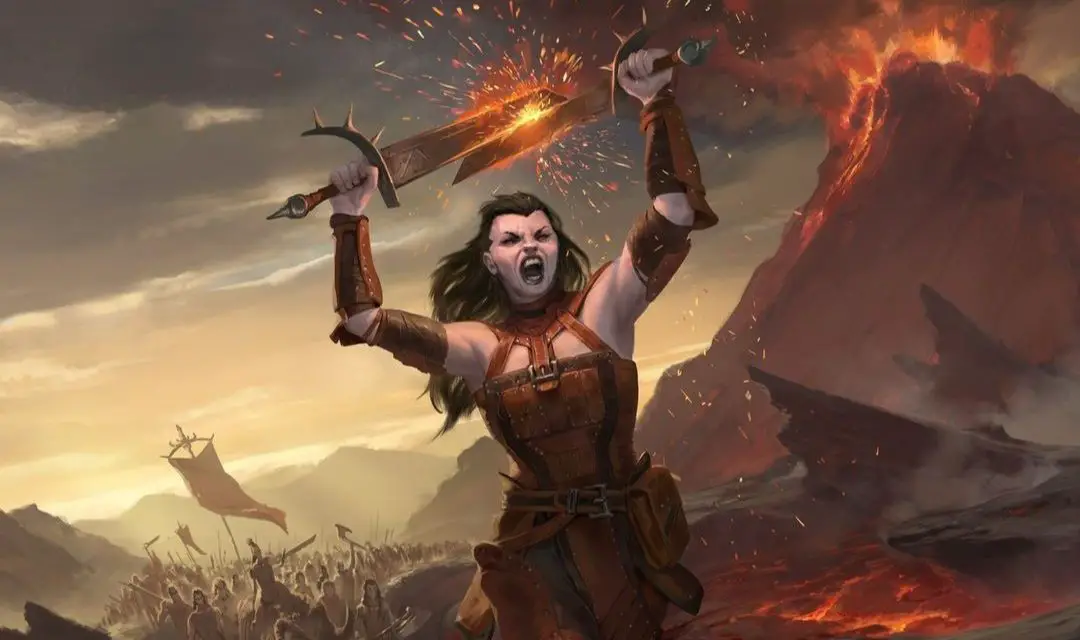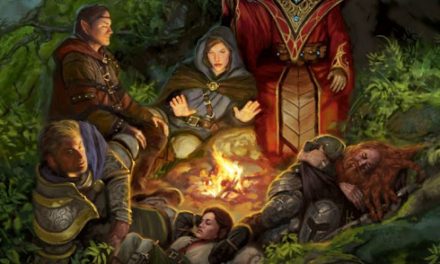With the ability to harness the ancient magic of runes, Rune Knight Fighters add some giant-sized utility to their already impressive kit.
But what exactly are these runes, you ask? They’re the key to unlocking the true potential of the Rune Knight Fighter subclass.
Based on the ancient practices of the Giants, these magical symbols grant Rune Knights incredible abilities and enhance their physical attributes.
With the mystical power of these runes at your fingertips, you can become a true force to be reckoned with!
So, grab your weapons and prepare to harness the power of the Giants with this guide to the Rune Knight Fighter in D&D 5e!
What is the Rune Knight Fighter in D&D 5e?
The Rune Knight Fighter subclass is a unique and powerful option available to players in D&D 5e.
As the name suggests, Rune Knights use the power of ancient runes to enhance their martial prowess and unlock a range of magical abilities.
A character might have learned to unlock these runes’ power by studying those left by artisans from various groups of giants.
On the other hand, they might have learned this from a scholar who has heavily researched giant society and lore. Learning from the scholar, the Rune Knight could have found new ways to combine the runes’ power with their own martial abilities.
Of course, it’s even possible for the Rune Knight to have learned these techniques directly from giants themselves!
Whatever the case may be, Rune Knights know that giant runes and skill in combat go together like peanut butter and jelly or Bards and cheesy pickup lines.
There are six runes to choose from in total (one for each type of giant). As you level up, you will continue collecting more up to a maximum of five.
This adds a strong level of versatility to the Rune Knight Fighter and ensures that they can always be very relevant in any party composition.
While they do get some very cool features (which we’ll cover in just a moment), these runes are easily the most important part of the subclass.
The Rune Knight Fighter can be found in Tasha’s Cauldron of Everything alongside the Psi Warrior Fighter.
Role in the Party
The Rune Knight Fighter’s role in an adventuring party can vary depending on your own preferences and the needs of your party. However, due to their unique abilities, Rune Knights can excel in a variety of roles!
One of the most obvious roles for a Rune Knight Fighter is that of a tank.
With the ability to increase their size and apply a ton of pressure to enemies, Rune Knights are excellent at keeping their more vulnerable party members safe. Options such as the Hill, Cloud, Stone, and Fire runes work especially well for a tanky Rune Knight.
Naturally, Rune Knights can also excel in a damage-dealing role.
With their ability to enhance their physical attributes, they can deal significant damage to enemies both at range and in melee combat.
Finally, Rune Knights can also be remarkably effective in more of a support role.
Each rune grants some very useful passive effects that can bring some interesting utility to the party while enhancing the Rune Knight’s skills and overall survivability.
If you can effectively manage your runes, you should have no trouble being an active contributor to your party’s success!
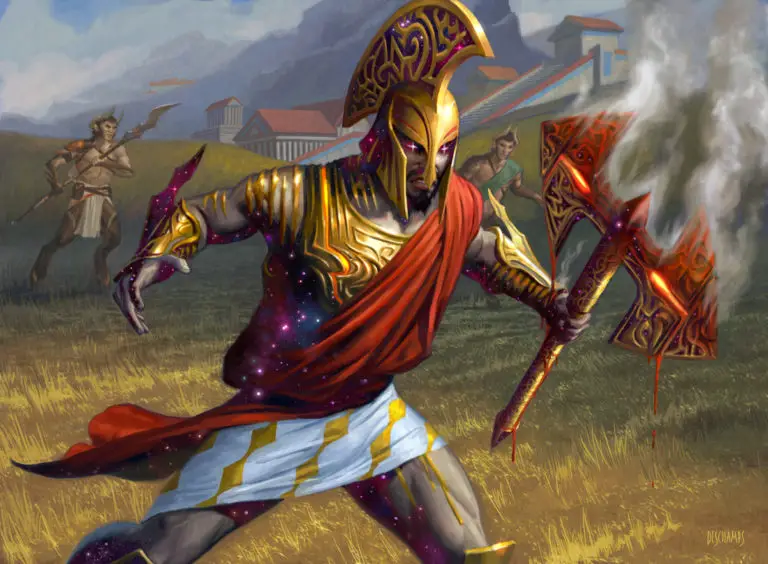
Rune Options for Rune Knight Fighters 5e
Before we dive into the features you gain from the Rune Knight subclasses, let’s go over your rune options.
In many ways, these are more important than most of your subclass features.
For now, we’ll focus on the effects of each rune. We’ll go over how to gain and use runes when we cover the Rune Carver feature in the next section.
Each rune has two effects: one passive and one active.
The passive effects work as long as the item that you have inscribed them on is on your person (either being worn or held.)
Active effects are activated and can only be used so many times (once, but eventually twice) before needing to recharge on a short or long rest.
Cloud Rune
The Cloud Rune grants its wielder the deceptive magic of Cloud Giants.
Passive Effect:
You have advantage on Dexterity (Sleight of Hand) and Charisma (Deception) checks.
If you’re multiclassing between Rune Knight Fighter and Rogue, this can be incredibly useful. While it’s not useless for those who are strictly going Fighter, the uses become a bit more uncommon.
Active Effect:
When you or a creature you can see within 30 feet of you is hit by an attack roll, you can use your reaction to invoke this rune and choose a different creature within 30 feet of you, other than the attacker.
The chosen creature becomes the target of the attack, using the same roll. This magic can transfer the attack’s effects regardless of the attack’s range.
Once you invoke this rune, you can’t do so again until you finish a short or long rest.
Now this, on the other hand, has a ton of applications.
The obvious use is to defend an ally while also dealing some cheeky damage to another enemy. Worst case, you might move an attack away from a weaker ally onto a more heavily armored one.
For example, if you’re only fighting one enemy (and therefore don’t have another enemy to move the attack to) and that enemy is about to lay down the hurt on a weakened ally, you might move the attack to the plate-clad Paladin instead.
Just be aware that this isn’t an automatic hit against the new target.
For this to be used, the first attack must hit the target. When you activate this rune to redirect the attack, it must then still beat the new target’s armor class.
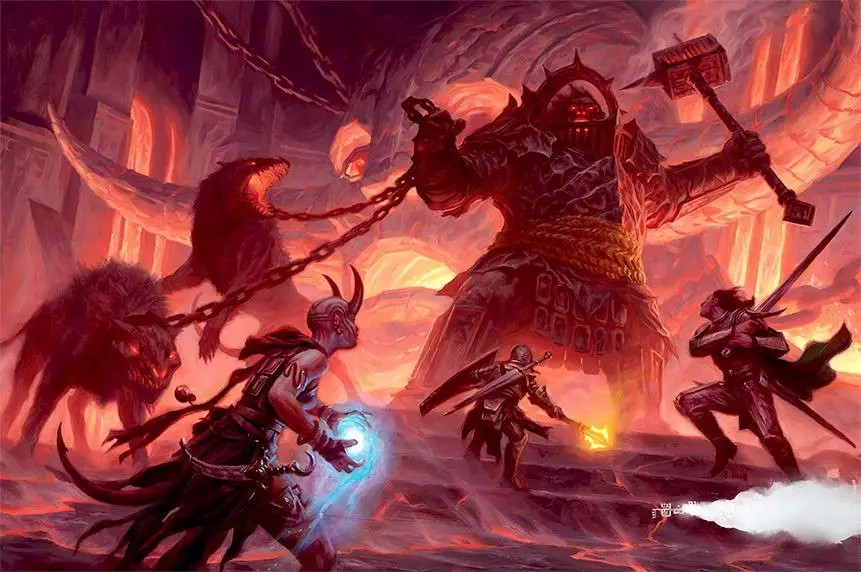
Fire Rune
The Fire Rune grants its wielder the supreme craftsmanship abilities of a Fire Giant.
Passive Effect:
Your proficiency bonus is doubled for any ability check you make that uses your proficiency with a tool.
You’re effectively gaining Expertise with every tool that you have proficiency with.
Not bad at all!
If you don’t have a Rogue in your party (or if you just want to be extra sure that you can get into things/places), I’d strongly recommend picking up proficiency in Thieves Tools’ as well to get some exceptional value out of this.
Active Effect:
When you hit a creature with an attack using a weapon, you can invoke the rune to summon fiery shackles: the target takes an extra 2d6 fire damage, and it must succeed on a Strength saving throw or be restrained for 1 minute.
While restrained by the shackles, the target takes 2d6 fire damage at the start of each of its turns. The target can repeat the saving throw at the end of each of its turns banishing the shackles on a success.
Once you invoke this rune, you can’t do so again until you finish a short or long rest.
Obviously, this will be more useful against creatures who aren’t super strong. But it will absolutely ruin the day of any weakling (spellcasters or enemies who tend to focus more on mobility than strength) you snare with it.
While they’re restrained and taking fire damage, you and your allies can dogpile them with advantage on your attacks against them!
Frost Rune
The Frost Rune grants its wielder the raw might of the Frost Giants.
Passive Effect:
You have advantage on Wisdom (Animal Handling) and Charisma (Intimidation) checks.
You might benefit from the Animal Handling bonus, but that tends to be a less common skill in many games. However, having advantage on Intimidation as a Fighter can be incredibly useful when you have to get tough with some NPCs.
Active Effect:
You can invoke the rune as a bonus action to increase your sturdiness. For 10 minutes, you gain a +2 bonus to all ability checks and saving throws that use Strength or Constitution.
Once you invoke this rune, you can’t do so again until you finish a short or long rest.
I wouldn’t say this is horrible, but it definitely doesn’t stand out as much as the other options available to the Rune Knight Fighter.
Strength saving throws aren’t particularly common and, as a Fighter, you’ll likely be okay anyway. Worst case, your Giant’s Might feature will be giving you advantage on checks and saves using your Strength ability anyway.
The bonus to Constitution is decent, but I don’t know that it’s worth one of your precious rune slots. I’d suggest buffing your CON score with one of your Ability Score Increases instead of wasting a slot on this.

Stone Rune
The Stone Rune grants its wielder the keen insight of the Stone Giants.
Passive Effect:
You have advantage on Wisdom (Insight) checks and you have darkvision out to a range of 120 feet.
Fighters absolutely benefit from having a good Wisdom score and having advantage on Insight checks can be incredibly useful.
Though the real star here is that 120 feet of darkvision. If you’re a race that doesn’t get darkvision to start with (like Human, Dragonborn, or Halflings for example), this is a game-changer.
But even if you do start with darkvision because of your character’s race, that’s typically just 60 feet. You’re still gaining a lot from this rune by doubling that range!
Active Effect:
When a creature that you can see ends its turn within 30 feet of you, you can use your reaction to invoke this rune and force the creature to make a Wisdom saving throw. Unless the save succeeds, the creature is charmed by you for 1 minute.
While charmed in this way, the creature has a speed of zero and is incapacitated, descending into a dreamy stupor. The creature repeats the saving throw at the end of each of its turns, ending the effect on a success.
Once you invoke this rune, you can’t do so again until you finish a short or long rest.
This is an interesting option that can be useful for shutting down a high-priority enemy. Like most “save or suck” spells/effects, how useful it is depends on whether or not the enemy makes their save.
If the target does fail their Wisdom, they’ll be helpless in the meantime.
Just be aware that they’re going to be making these saves at the end of each of their turns. So do whatever you’re going to do quickly before they snap out of it!
Hill Rune
The Hill Rune is available to Rune Knight Fighters who are level 7 or higher. It grants its wielder the incredible resilience of a Hill Giant.
Passive Effect:
You have advantage on saving throws against being poisoned and you have resistance against poison damage.
There is no shortage of enemies, traps, and effects with poison. Advantage on saving throws (and resistance to any poison damage being dealt) is a great buff that will serve you well throughout your entire adventure.
It’s slightly less impressive if you’re a dwarf (since dwarves already get this), but that’s no reason to disregard the Hill rune. The active effect is also pretty freaking awesome!
Active Effect:
You can invoke this route as a bonus action, gaining resistance to bludgeoning, piercing, and slashing damage for 1 minute.
Once you invoke this rune, you can’t do so again until you finish a short or long rest.
This effect makes your Rune Knight exceptionally tanky since you’ll only be taking half as much damage from bludgeoning, piercing, and slashing.
The only downside to this is trying to figure out when the “best time” to use it is.
But don’t let that stress you out too much. You don’t want to make the mistake of never using this because you’re always waiting for “the perfect moment.” Use your judgment and, when the time is right, give your enemies a new reason to be scared of Hill Giants!
Storm Rune
The Storm Rune is available to Rune Knight Fighters who are level 7 or higher. It grants the wielder the divination ability of a Storm Giant Seer.
Passive Effect:
You have advantage on Intelligence (Arcana) checks, and you can’t be surprised as long as you aren’t incapacitated.
In most cases, you probably won’t have much to do with Arcana checks. That’s typically best left to Wizards, Sorcerers, Bards, Clerics, Druids, Warlocks…
You get the point…
But not having to worry about being surprised is an excellent buff. This is especially true when venturing into environments like the Underdark where enemies love to ambush you.
Active Effect:
You can invoke this rune as a bonus action to enter a prophetic state for 1 minute or until you are incapacitated.
Until the state ends, when you or another creature you can see within 60 feet of you makes an attack roll, a saving throw, or an ability check, you can use your reaction to cause the roll to have advantage or disadvantage.
Once you invoke this rune, you can’t do so again until you finish a short or long rest.
This is a crazy useful effect that has enough range to cover pretty much any encounter you find yourself in.
It shines best when used in those very high-stakes moments.
An enemy landing a critical hit on a party member, an ally failing a death saving throw, or setting an ally up for a powerful effect (like a must-hit Divine Smite or a save-or-suck spell/effect) is what most immediately comes to mind.
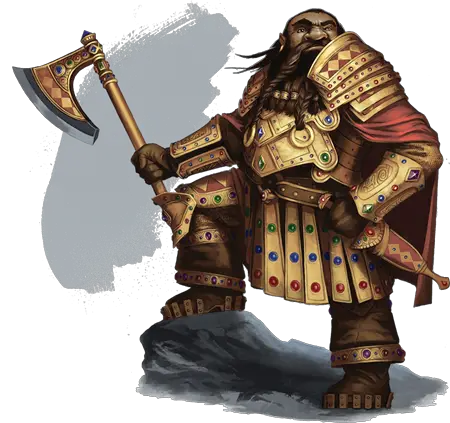
Rune Knight Fighter Features 5e
Now let’s look over what features you’ll specifically be gaining as a Rune Knight Fighter in D&D 5e.
As always, we’ll look at what each feature and rune option is as well as cover how you can get the most use out of it.
Remember: the key to playing a Rune Knight well is making sure to get the best use out of your runes. While you won’t be getting many uses of their active ability per day, they can make a GIANT impact if used cleverly!
Recommended: Mastering the Fighter’s Action Surge in D&D 5e
Bonus Proficiencies (Level 3)
We’re kicking things off with some appropriately themed flavor for your character.
You gain proficiency with smith’s tools, and you learn to speak, read, and write Giant.
Smith’s tools can actually be very handy, particularly when paired with the Fire Rune. Getting Expertise with all tools means you’ll have no trouble with any kind of crafting task you encounter.
As for being able to speak, read, and write Giant, it’s an incredibly useful language for you to know. You’ll presumably be working diligently to learn more about Giant cultures, after all!
Though you’re also likely to be the obvious choice to do the talking if the party encounters any Giants.
In such cases, having the Cloud rune (for advantage on Deception checks) and/or the Frost rune (for advantage on Intimidation checks) can be especially useful!
If you’re dealing with more clever Giants, having the Stone rune (for advantage on Insight checks) will also be useful for determining their true motives.
Rune Carver (Level 3)
The Rune Carver feature is the Rune Knight Fighter’s most important feature.
Starting at level 3, this is how you harness the power of mystical giant runes to enhance your own abilities.
You learn two runes of your choice and each time you gain a level in this class, you can replace one rune you know with a different one from this feature.
When you reach certain levels in this class, you learn additional runes, as shown in the Runes Known table.
Whenever you finish a long rest, you can touch a number of objects equal to the number of runes you know, and you inscribe a different rune onto each of the objects.
To be eligible, an object must be a weapon, a suit of armor, a shield, a piece of jewelry, or something else you can wear or hold in a hand.
Your rune remains on an object until you finish a long rest, and an object can bear only one of your runes at a time.
If a rune requires a saving throw, your Rune Magic save DC equals 8 + your proficiency bonus + your Constitution modifier.
Taking time on a long rest to inscribe your chosen runes on your equipment, you gain the effects of those runes.
The number of runes that you know (and can inscribe onto your equipment during a long rest) is determined by your Fighter level, as shown below.
| Fighter Level | Number of Runes |
| 3 | 2 |
| 7 | 3 |
| 10 | 4 |
| 15 | 5 |
Rune Carver – Some Important Considerations
Keep in mind that there are a few considerations to be aware of with this feature though.
First things first, if you lose the object that you have the rune inscribed on, you are also losing the benefits you gain from that rune.
For example, if a Rust Monster decides to eat the longsword that you’ve inscribed with a Cloud rune, you won’t be getting the benefit of advantage on Deception and Sleight of Hand checks until you inscribe the rune on another item during your next long rest.
Secondly, keep in mind that the equipment that your Rune Knight inscribes runes on is not made magical.
This means that creatures like Specters that resist nonmagical damage will still be a major nuisance for you.
Lastly, don’t worry too much about making “the right choice” when it comes to the runes you are choosing.
If you find that you’re not getting as much value from a rune as you had hoped or that you used to, you can always swap it for a different option when you gain another Fighter level!
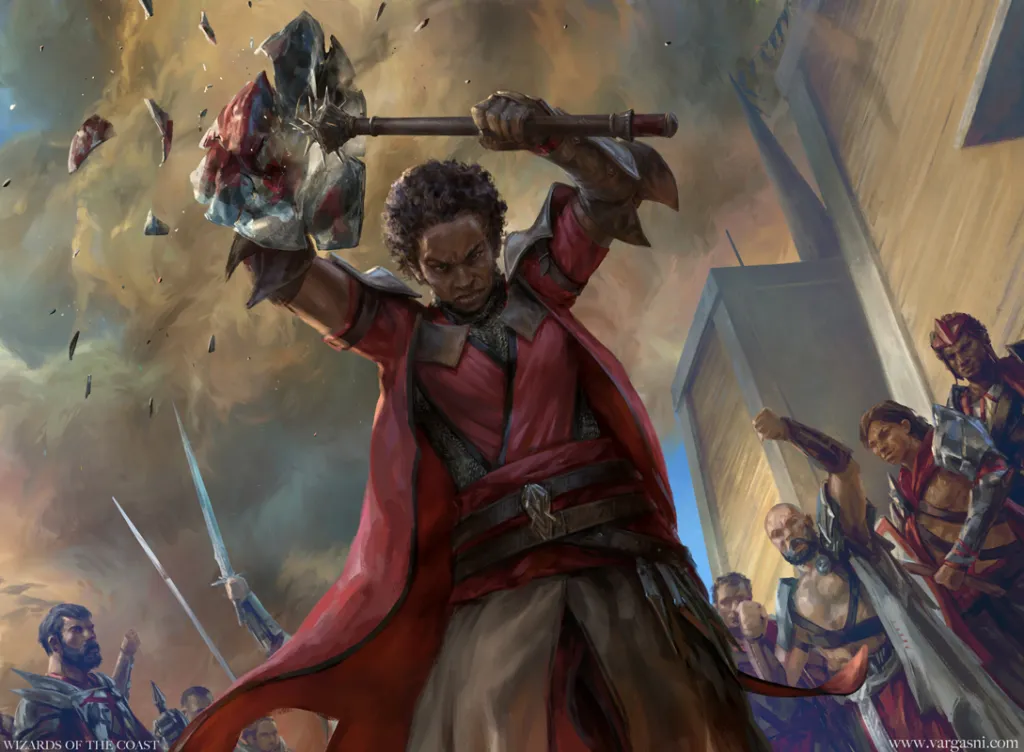
Giant’s Might (Level 3)
The last feature you gain at level 3 is the ability to grant yourself the strength of Giants!
You’ll probably also be able to single-handedly keep the local tailor in business if you use this regularly enough!
There are a few different components to Giant’s Might, so let’s take it piece by piece…
As a bonus action, you magically gain the following benefits, which last for 1 minute.
You can use this feature a number of times equal to your proficiency bonus, and you regain all expended uses of it when you finish a long rest.
Easy enough!
The benefits of this feature last for 1 minute and are activated as a bonus action. As you level up and your proficiency bonus increases, you’ll get more uses out of this per long rest.
If you are smaller than Large, you become Large, along with anything you are wearing. If you lack the room to become Large, your size doesn’t change.
Taking a page from the Incredible Hulk, you get a great increase in your size as you activate Giant’s Might. Taking up more space means that you’re better able to protect your allies and push your enemies around.
Note that this assumes you have the space to change your size. If you don’t, you’ll still get the other benefits of activating this feature.
Of course, your size becoming Large as long as you’re normally smaller than that opens a funny opportunity. For maximum growth shenanigans, play a small race like a Gnome, Halfling, or Fairy Rune Knight!
“GNOME SMASH!”
You have advantage on Strength checks and Strength saving throws.
Great for lifting things, not getting pushed around, or using your Athletics skill.
Once on each of your turns, one of your attacks with a weapon or an unarmed strike can deal an extra 1d6 damage to a target on a hit.
An extra 1d6 damage per turn is okay, I suppose. It will have a better impact at lower levels but be less noticeable at higher tiers of play.
While this isn’t the biggest benefit of this feature, every little bit helps!
Runic Shield (Level 7)
At level 7 the Rune Knight gets a potentially incredibly useful defensive feature.
When another creature you can see within 60 feet of you is hit by an attack roll, you can use your reaction to force the attacker to reroll the d20 and use the new roll.
You can use this feature a number of times equal to your proficiency bonus, and you regain all expended uses when you finish a long rest.
Curiously, this does seem to somewhat slightly compete with the Cloud Rune’s activated effect.
But anyhow…
60 feet is an incredible range and will likely be more than enough for pretty much any encounter you’re in.
The thing to be mindful of with this feature is that there is also the potential to make things MUCH worse if you use this incorrectly.
Remember: the creature is rerolling their attack. They are not being afflicted with disadvantage.
For example, let’s say that an Umber Hulk is clacking its mandibles and trying to take a bite out of your party’s Sorcerer. The Sorcerer has an armor class of 12 and the Umber Hulk just got a 15 to hit (thanks to its +8 attack modifier.)
Trying to protect your Wizard, you activate Runic Shield and force the Umber Hulk to reroll.
Now, the odds of the Umber Hulk rolling a 3 or less (and therefore missing) are pretty slim. However lucky the Sorcerer is feeling, it’s definitely not an ideal situation.
But there’s another risk here: what if the Umber Hulk rerolls and now lands a critical hit with a natural 20?!
As the monster closes in on the terrified Sorcerer, it gives you a quick “thank you” nod before eating its dinner.
While you should absolutely use Runic Shield when an enemy is landing a critical hit, be mindful of these other factors when using it.
Otherwise, you just might end up making things worse for your ally if they don’t have a realistic or decent chance of dodging the attack!
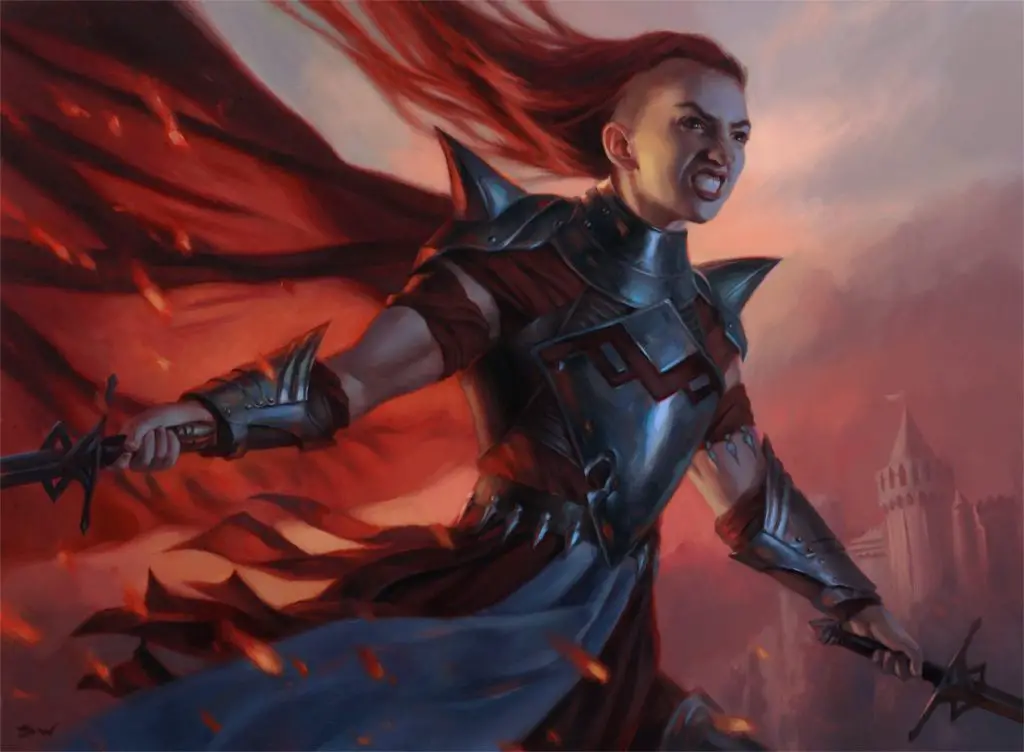
Great Stature (Level 10)
Moving on, I’m not going to sugarcoat this…
The Rune Knight’s level 10 feature is…
well…
it’s something…
When you gain this feature, roll 3d4. You grow a number of inches in height equal to the roll.
Moreover, the extra damage you deal with your Giant’s Might feature increases to 1d8.
You get bigger.
Maybe just a few inches. Maybe a whole foot.
Short of making a new mark on the doorframe at mom’s house, there’s not really a benefit to this. But I’m sure your Rune Knight’s parents are very proud of how big you’re getting!
You’ll also deal slightly more damage with your Giant’s Might feature.
Instead of an extra 1d6 damage per turn, you’re dealing an extra 1d8 damage per turn. This means that you’ll be going from an average of 3-4 extra damage per turn, you’re dealing an average of 5 extra damage per turn.
I’m not going to lie, if not for gaining an extra Giant Rune at level 10 (and how powerful those runes are), I would be actually angry about this feature.
But, all things being equal, it’s okay.
*furiously carves slightly larger rune into slightly larger armor*
Master of Runes (Level 15)
Ok, so maybe the Rune Knight’s level 10 is a bit of a flop, but level 15 is absolutely incredible!
Not only will you be gaining your fifth rune for your Rune Carver feature, but Master of Runes turns your kit up to 11!
You can invoke each rune you know from your Rune Carver feature twice, rather than once, and you regain all expended uses when you finish a short or long rest.
That’s right, baby! You’re now getting TWICE as many uses of your runes now AND they all recharge on a short rest!
That’s two uses of each of your runes before you need to take a breather and get them all back.
All things considered, it’s very unlikely you’ll need to use all 10 of these charges between short rests, but it’s always nice to have the option.
Maybe you had to act with some restraint up to this point, but that time has all but completely passed now!
Runic Juggernaut (Level 18)
The Rune Knight Fighter’s capstone feature is yet another improvement to the Giant’s Might feature.
Sure, I’ve done some grumbling about it previously, but it’s actually much more useful with the Runic Juggernaut feature!
The extra damage you deal with the Giant’s Might feature increases to 1d10.
Moreover, when you use that feature, your size can increase to Huge, and while you are that size, your reach increases by 5 feet.
So, as with Giant’s Might and Great Stature, the extra damage still isn’t much to write home about.
But what DOES make this great is the extra 5 feet of reach!
You’ll have no problem smacking enemies and, honestly, this can be made absolutely insane if you are wielding a polearm and/or playing as a Bugbear.
Heck, a Bugbear Rune Knight Fighter wielding a polearm that uses Runic Juggernaut would have a hilarious reach of 20 feet. (5 feet normal + 5 from Runic Juggernaut + 5 from the polearm’s Reach + 5 from the Bugbear’s Long-Limbed trait.)
If you’re feeling ridiculous, you could even take the Polearm Master and Sentinel feats to become your character’s most problematic self.
Though, of course, there’s still the mental image of a Gnome Rune Knight now being able to have a full-on kaiju battle with something like the Tarrasque, Kraken, or an Ancient Dragon.
Which reminds me…
Keep in mind that, as a Huge creature, your Rune Knight Fighter can now grapple with gargantuan creatures because they are only one size category larger than you.
Do with that information what you will.
(Disclaimer: Just do it quickly! Giant’s Might still only lasts 1 minute, and they’ll likely have some strong opinions about you putting them in a gargantuan chokehold.)
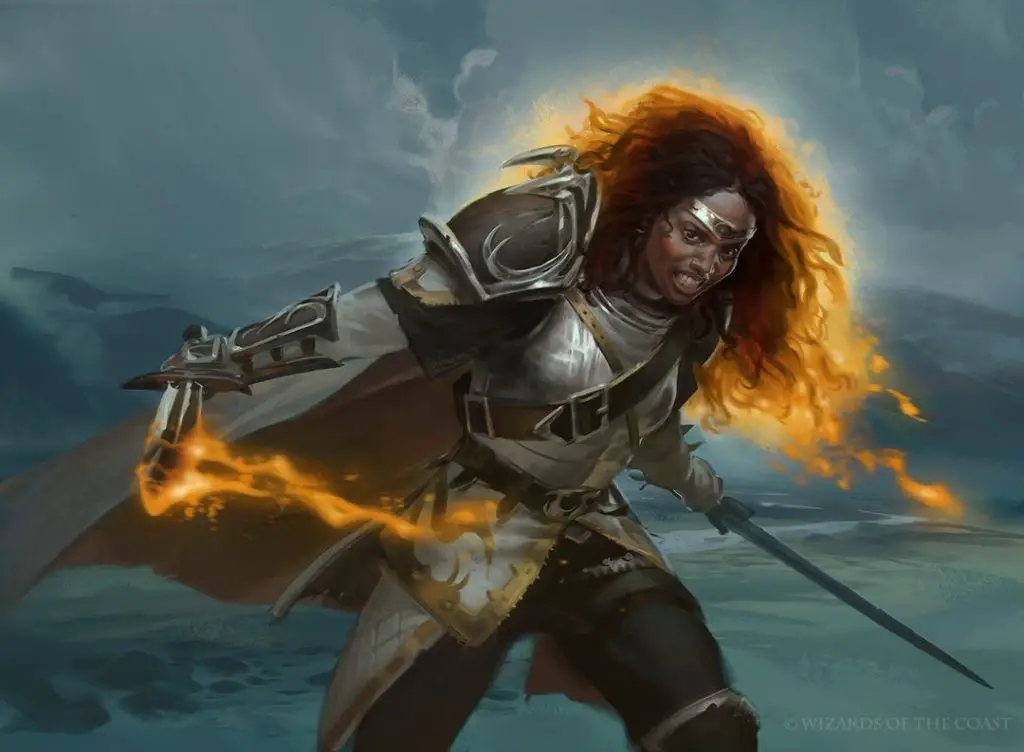
Connections
As we covered, the Rune Knight Fighter subclass is based on the ancient magic of runes and the power of giants.
As such, there are several hooks that could be used to bring a Rune Knight Fighter into an adventure based on the theme of the subclass.
One hook could be a quest to recover lost or stolen rune artifacts.
Perhaps a powerful artifact has been stolen from a temple of the giants, and the Rune Knight has been tasked with recovering it.
Alternatively, the Rune Knight may be seeking to recover a lost artifact that belonged to their ancestors, which could tie into their backstory and motivations.
Another hook could be a conflict with a group of giants or other powerful creatures.
Perhaps the party has been hired to deal with a group of giants that has been causing trouble in a nearby town, and the Rune Knight’s knowledge of giant lore and ability to use the Giants’ runes against them could be invaluable in the fight.
Alternatively, the party may stumble upon a group of giants who are in possession of a powerful artifact, and the Rune Knight could be called upon to negotiate or fight for its recovery.
Finally, a hook could be a quest to uncover the secrets of ancient runes and their connection to the giants.
Perhaps the party has been hired by a scholar or wizard who is seeking to uncover the true power of the runes, and the Rune Knight’s knowledge and abilities could be crucial in deciphering ancient texts and unlocking the secrets of the past.
Is the Rune Knight Fighter Good?
The Rune Knight Fighter subclass is an excellent choice for players who want to play a frontline character while also delving into the more mystical elements of Giant lore.
From everything I’ve seen, this is a subclass that often gets passed over. The only reason I can think for that is that there’s so much to it that it might scare off some players who are curious about it.
And that’s fair.
But once you see how all of this neatly ties together, it becomes a much less intimidating subclass to play.
The biggest trick to getting the most value out of the Rune Knight Fighter’s kit is knowing when and how to use their features for the greatest effect.
The name of the game here is “resource management.”
If you can get that down, you’ll be in for quite a treat with a character that is adaptable and ready to make a heavy impact in nearly any situation.
Recommended: Ranking EVERY Fighter Subclass in D&D 5e!
Conclusion – Rune Knight Fighter in D&D 5e
Whew!
There is certainly A LOT to cover with the Rune Knight Fighter, but I hope you’ve found this guide helpful!
As always, I’d love to know your thoughts on this subclass in the comments.
In my opinion, there’s a ton of theme to this one and it really captures the imagination while still bringing an excellent level of value to any party!

